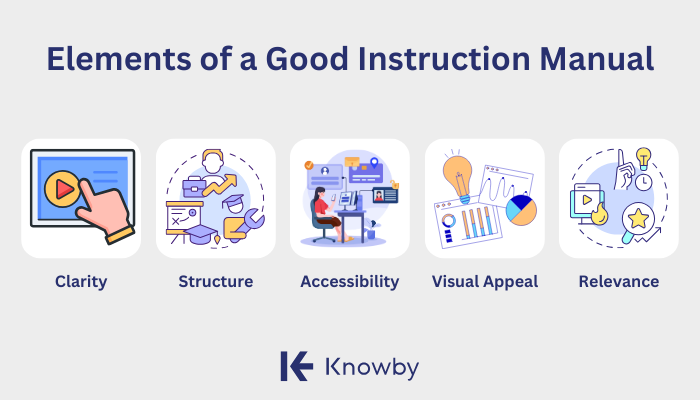Create Instruction Manuals Effortlessly with Knowby

January 15, 2025

Improving user journey begins with an instruction manual. It starts with a simple scenario. Whether it’s software, equipment, or an everyday appliance, struggling to understand how a product works is one of the fastest ways to sour the customer experience. It’s not just about convenience—poor instructions erode trust. They tell users, “We don’t care enough to guide you.”
Now, imagine a different scenario. A user opens a product, and the instruction manual is visually appealing, easy to follow, and interactive. What would happen? The change is clear, all thanks to user instruction manuals.
This blog will explain what it takes to create manuals that truly make a difference and explore how Knowby, a trusted instruction manual creation platform, can simplify the process.
What Is In An Instruction Manual?
An instruction manual is a document that provides clear, step-by-step guidance on how to operate or assemble a product, use a service, or complete a specific task. It serves as a roadmap and a bridge between complex processes and user clarity. Whether for onboarding new employees, maintaining equipment, or executing standard operating procedures (SOPs), these manuals ensure consistency, accuracy, and efficiency.
Differences from Other Documentation
Instruction manuals are sometimes called user guides or manuals. While instruction manuals share similarities with user manuals and other forms of technical documentation, they serve a different purpose. Here's how they differ from user guides and other troubleshooting information and FAQs:
- User Guides
Unlike instruction manuals, user guides take a broader approach. They cover topics related to a product, including features, configurations, and various use cases. If an instruction manual tells users how to do something, a user guide tells them what’s possible with the product. For instance, a software user guide may explain advanced features or customisation options beyond basic instructions.
- Troubleshooting FAQs
Troubleshooting FAQs focus on addressing specific problems users may encounter. They are reactive, providing solutions to issues after something has gone wrong. Meanwhile, an instruction manual is proactive—it aims to prevent problems by guiding users through proper operation from the very start.
Here's a table of comparison to help you understand the differences better:
|
Feature |
Instruction Manual |
User Guide |
Troubleshooting FAQ |
|
Purpose |
Provides step-by-step directions for using or assembling a product. |
Covers all aspects of a product or service comprehensively. |
Resolves common issues and answers frequently asked questions. |
|
Audience |
Primarily users needing basic instructions for operation. |
Both beginners and advanced users seeking in-depth knowledge. |
Users facing specific problems or seeking quick solutions. |
|
Content |
|
|
|
|
Format |
Simple, digital or printed and focused on step-by-step processes. |
Detailed, structured, and often includes advanced use scenarios. |
Concise, organised into questions and answers for quick navigation. |
|
Visuals |
May include diagrams and illustrations to assist assembly or usage. |
Often includes screenshots, diagrams, and comprehensive visuals. |
Limited visuals, focusing more on text-based answers. |
|
Use Cases |
For basic product setup, operation, or assembly. |
For understanding advanced features and maximising product potential. |
For resolving specific issues or clarifying product-related concerns. |
|
Accessibility |
Easy to understand for all users, including beginners. |
Tailored for various user skill levels, from novice to expert. |
Designed for quick navigation and immediate solutions. |
|
Length |
Shorter and more straightforward. |
Typically longer with detailed sections. |
Brief and focused on resolving problems. |
Elements of a Good Instruction Manual
What should an instruction manual include? An instruction manual usually consists of (this is not a finite or mandatory list of inclusions and can be adapted to each particular instruction):
- Title Page: Product name and company logo.
- Table of Contents: Overview of sections for navigation.
- Introduction: Brief product overview and purpose.
- Safety Information: Important warnings and precautions.
- Setup Instructions: Steps for initial setup or assembly.
- Operating Instructions: Detailed usage steps.
- Troubleshooting Tips: Solutions to common issues.
- Technical Specifications: Key product details.
- Warranty Information: Warranty and support details.
But what makes an instruction manual truly effective? Writing a good instruction manual means focusing on a few key elements. Here’s what makes a manual successful:

Clarity
Clarity is the foundation of any good instruction manual. The language should be simple, direct, and free from technical jargon unless necessary—if such terminology is used, it must be clearly explained. Clear instructions reduce user confusion and allow tasks to be completed quickly and accurately. For example, instead of saying, “Initiate the activation procedure,” you can say, “Press the Start button.”
Structure
A good instruction manual is built with a logical flow. This often means organising content into sections that follow a sequential process. Using numbered lists, headings, and subheadings breaks the content into manageable chunks, making information easy to find and follow.
Accessibility
An instruction manual should be easy to navigate and search. Tools such as a clear table of contents, index, and even digital search functionality (for electronic manuals) can help users quickly locate the information they need. For instance, bold print or icons can highlight critical information, steps or warnings to avoid getting overlooked.
Visual Appeal
Supporting text with visuals such as diagrams, images, or videos enhances comprehension. A well-labelled diagram can often communicate steps more effectively than text alone. For example, in a furniture assembly manual, including an exploded diagram of parts with labels can reduce guesswork and help users follow instructions more confidently.
Relevance
Content should be focused and tailored specifically to the audience’s needs. Avoid overloading the manual with unnecessary details. Instead, keep the information concise and ensure that steps or examples apply directly to the user experience. For instance, an instruction manual for home appliances should focus on common usage scenarios rather than niche functions.
Following these principles can make the difference between a manual that informs and a product manual that frustrates users. You can even lessen this frustration by utilising available technology, such as a digital instruction manual.
How To Create A Work Instructions Manual?
You can create these digital instruction manuals through various tools available online. The easiest and newest is to use digital work instruction software or platforms like Knowby. Here's how to get started:
Step 1: Visit the Knowby Website
Navigate to Knowby.co. Here, you will find information about the platform's features and benefits. To create your digital instructions manual, create an account or start your free trial. Knowby offers a 30-day free trial, allowing you to explore its features without commitment.
Step 2: Register, Verify, and Complete Profile
You will be directed to a registration form. Enter the required information, including your name, email address, and password. Verify. Then, complete your profile by adding additional details such as:
- Profile picture
- Job title
- Contact information
Step 3: Explore the Dashboard
After setting up your account, take some time to familiarise yourself with the Knowby dashboard. Here, you can start creating work instructions, manage existing content, and access various features to enhance your workflow.
Step 4: Start Creating Instructions
Once your account is set up, Knowby’s intuitive interface makes it easy to create comprehensive instructions. Combine text, images, and videos to design clear, engaging user manuals that align with the key elements.
Best Practices for Creating Instruction Manuals
When you are ready to write your instruction manual, keep these best practices in mind:
Planning
It all starts with planning. Before writing anything, you should:
- Identify Your Audience:
Understanding who will use your manual. Ask:
- Who is the manual for? Are they beginners, intermediate users, or experts?
- What are their needs? Do they require extra guidance, or are they already familiar with basic concepts? For instance, a manual for assembling a child’s toy should use simple language and clear visual diagrams, while a manual for technical equipment may include more detailed technical specifications.
- Define the Scope
This involves establishing:
- Goals: What do you want the manual to achieve?
- Boundaries: What will the manual cover, and what won’t it address?
- Gather Materials
Compile all the resources needed before writing. This can save time and ensure that nothing is overlooked. Consider:
- Tools or equipment required for the task
- Images, videos, or diagrams to complement the instructions
- Technical specifications or safety guidelines from other materials
- Create an Outline
An outline provides a roadmap for logically arranging your content. Start with broad sections and break them into smaller, actionable items.
Here’s an example outline for an instruction manual:
- Title Page and Introduction: Briefly explain what the manual is for and introduce the product or task
- Table of Contents: Include sections and page numbers for easy navigation
- Step-by-Step Instructions: Provide detailed, sequential steps to complete the task
- Troubleshooting Section: Address common issues
- FAQs: Answer common questions beyond the main instructions.
- Contact Information or Support Links: Offer ways for users to get further help if needed
Writing and Designing
After planning comes writing user instruction manuals and designing phase. An effective instruction manual is both an art and a science. You can easily use platforms like Knowby and access tools to write and design digital manuals. Always go for tools with features like:
1. Content Editor
Knowby has a built-in content editor, which makes creating and formatting text simple. Follow these tips to structure your instructions clearly and logically:
- Add Headings and Subheadings - Break your instructions into sections using headings and subheadings. For example, use headings for major sections like “Setup” or “Troubleshooting” and subheadings for specific tasks.
- Numbered Lists and Bullet Points - Sequence your instructions with numbered lists. Use bullet points for supporting information or optional tips. This formatting reduces cognitive load and improves readability.
- Use Text Formatting Tools - Use bold and italics for secondary notes or optional steps.
2. Adding Visuals
Visual aids enhance comprehension and reduce errors. Here’s why and how to use visuals effectively in Knowby:
- Why It Matters
- Images, diagrams, and videos provide clarity that text alone can’t always achieve. They’re especially helpful for illustrating complex tasks. Additionally, studies show that 65% of people are visual learners, making visual aids essential for effective communication.
- Tips for Effective Visuals
- Use high-quality images. Blurry or pixelated visuals can confuse users.
- Keep diagrams simple and focused—don't add extraneous details.
- Always add concise or small captions.
In this video, General Manager of M2 Overland, Nick Langan, explains why Knowby instructions have been a successful means of training staff who prefer visual learning:
3. Interactive Elements
With Knowby, incorporating interactive elements can make your instructions even more engaging. Features like clickable buttons, embedded tutorials, or live feedback options allow users to interact with the manual meaningfully. For example:
- Add a “Mark Step Complete” button so users can track their progress.
- Embed tutorial links or short videos that expand on specific steps directly within the guide.
4. Branding and Personalisation
Your product instruction manual should reflect your brand’s identity. Knowby provides customisation options to align the manual with your product specifications and branding:
- You can upload your company’s logo for brand recognition.
- You can choose custom colours and fonts that align with your company’s style guide.
- You can adjust the manual's design to match whether your audience prefers a formal or casual style.
How to Test and Refine the Instruction Manual
Creating an instruction manual doesn’t end with the initial draft. Once you’ve written and designed your manual, test and refine it. Knowby’s tools make it easy to collaborate, test with users, and update content as needed. With Knowby, you can conduct:
- Collaborative Review
Collaborating with your team is an essential part of refining your manual. With Knowby, you can invite team members to review and comment directly on your work.
- Tips for Effective Collaboration:
- Set a clear deadline for feedback submission to keep the process focused and on track.
- Use Knowby’s comment threads to address team members' concerns or questions.
- Record all suggestions for future reference, even if you don’t implement them immediately.
- Set a clear deadline for feedback submission to keep the process focused and on track.
- User Testing
Once your team provides input, it’s time to validate the manual with a small group of target users. Testing with real users ensures your instructions are clear, usable, and effective.
- Conducting User Tests: Share the draft manual with a test group that reflects your target audience. This could include new employees, customers, or less experienced users.
- Gathering Feedback: Provide a feedback form or survey to evaluate the manual’s clarity, ease of use, and helpfulness.
- Revisions and Updates
The user feedback you gather is only useful if you act on it. Knowby streamlines the revision process, enabling you to make edits efficiently:
- Editing and Updating: Use Knowby’s intuitive editor to revise content based on feedback. This could include rephrasing unclear steps, adding new visuals, or rearranging sections for better flow.
- Tracking Changes: Use Knowby’s version history to monitor updates and record past iterations.
Publishing and Sharing Your Instruction Manual
Once your instruction manual is complete, the next step is to share it with your audience. With Knowby, distributing your manual is seamless, thanks to its versatile export options and sharing features. Here's how to ensure your manual reaches users effectively while tracking performance.
- Export Options
Knowby provides several options for exporting your manual:
- PDF Format for a printable version of your manual.
- Online Link: Generate a shareable link that users can access anywhere.
- QR Code: Embed a QR code directly on your product packaging, printed materials, or communications. This is why Bearhug uses QR codes on its product packaging.
- Sharing with Users
How you distribute your manual plays a significant role in ensuring it reaches the right people effectively. Consider these methods:
- Email Distribution: Attach a PDF or share the online link in a customer welcome email.
- Website Integration: Embed the manual on your homepage or product-specific pages.
- Product Packaging Links: Include a QR code or link directly on your product packaging to give users instant access to the manual.
3. Tracking Performance
Publishing is just the start. To gauge your manual's success and identify improvement opportunities, use platforms with Feedback Collection, like Knowby and incorporate feedback forms within the manual or follow up with users to gather input on usability and effectiveness.
Review and refine your manual regularly for continuous improvement and compliance. For instance, if a specific step is changed, you can update each step individually as required.
Instructions Success Stories with Knowby
Knowby has empowered many industries and individuals to create effective instruction manuals that drive results. Below are some standout examples across different industries:
How Bearhug Achieved 30% Increase in Conversion Rate Using Knowby Instructions 
"Since we moved our customer onboarding demos over to Knowby, we've noticed a 30% increase in the amount of leads who go from receiving a sample to purchasing one."
Knowby helped Bearhug overcome a resistance to the product by providing clear, easily accessible instructions that could be displayed on the sample product via a QR code label.
Read the full Bearhug case study here.
How Cotecco Reduced Service Call-Outs with Digital Instructions
“Since implementing Knowby we have saved thousands in travel and repair costs. Knowby instructions have transformed how we support our remote clients, and it's had a significant impact on our bottom line.”
The high cost of service call-outs was cutting into profit margins significantly. When Cotecco saw Knowby instructions in action, it was a no-brainer as it was easy to create the instructions and for customers to access remotely. The QR code access, options to track each step, and the availability of different languages gave us the confidence that it was the right solution.
Read the full Cotecco case study here.
What is the Best Way to Create Instruction Manuals?
When businesses prioritise creating effective instruction manuals, the payoff in customer satisfaction is remarkable. Happy customers stay. Frustrated ones leave. The choice is as clear as the instructions should be.
From drafting clear, structured content to incorporating visuals and interactive elements, Knowby makes the entire process seamless. The platform’s robust features—such as collaborative editing, analytics for performance tracking, and branding tools—ensure your manual meets the highest standards while staying relevant.
Don’t wait to transform your instructions into a powerful communication tool. Start your free trial today and use Knowby for the best way to create the instructions.


Comments